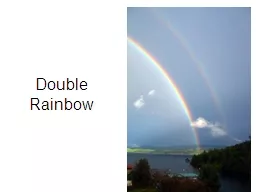/


1 2 Bar at the Folies Bergères by Edouard Manet 1882 3 Chapter 35 The concept of ID: 546422
Download Presentation The PPT/PDF document "Double Rainbow" is the property of its rightful owner. Permission is granted to download and print the materials on this web site for personal, non-commercial use only, and to display it on your personal computer provided you do not modify the materials and that you retain all copyright notices contained in the materials. By downloading content from our website, you accept the terms of this agreement.
Slide1
Double Rainbow
1Slide2
2
Bar at the
Folies
Bergères
’ by
Edouard
Manet
(1882)Slide3
3
Chapter 35
The concept of
optical interference
is critical to understanding many natural phenomena, ranging from color shifting in butterfly wings (iridescence) to intensity patterns formed by small apertures. These phenomena cannot be explained using simple geometrical optics, and are based on the wave nature of light.In this chapter we explore the wave nature of light and examine several key optical interference phenomena.
Interference
35-Slide4
4
Huygen’s Principle: All points on a wavefront serve as point sources of spherical secondary wavelets. After time
t
, the new position of the wavefront will be that of a surface tangent to these secondary wavelets.
Light as a Wave
35-
Fig. 35-2Slide5
5
Law of Refraction
35-
Index of Refraction:
Fig. 35-3
Law of Refraction:Slide6
6
Wavelength and Index of Refraction
35-
Fig. 35-4
The frequency of light in a medium is the same as it is in vacuum
Since wavelengths in n1 and n2 are different, the two beams may no longer be in phaseSlide7
7
The geometrical explanation of rainbows given in Ch. 34 is incomplete. Interference, constructive for some colors at certain angles, destructive for other colors at the same angles is an important component of rainbows
Rainbows and Optical Interference
35-
Fig. 35-5Slide8
8
Diffraction
35-
Fig. 35-7
For plane waves entering a single slit, the waves emerging from the slit start spreading out, diffracting.Slide9
9
Young’s Experiment
35-
Fig. 35-8
For waves entering a two slit, the emerging waves
interfere and form an interference (diffraction) pattern.Slide10
10
The phase difference between two waves can change if the waves travel paths of different lengths.
Locating Fringes
35-
Fig. 35-10
What appears at each point on the screen is determined by the path length difference
D
L
of the rays reaching that point.
Path Length Difference:Slide11
11
35-
Fig. 35-10
Maxima-bright fringes:
Minima-dark fringes:
Locating FringesSlide12
12
Coherence
35-
Two sources to produce an interference that is stable over time, if their light has a
phase
relationship
that does not change with time:
E
(t)=
E0cos(
wt+
f
)
Coherent sources
:
Phase
f
must be well defined and constant. When waves from coherent sources meet, stable interference can occur. Sunlight is coherent over a short length and time range. Since laser light is produced by cooperative behavior of atoms, it is coherent of long length and time ranges
Incoherent sources
:
f
jitters randomly in time, no stable interference occursSlide13
13
Intensity in Double-Slit Interference
35-
Fig. 35-12
E
1
E
2Slide14
14
Fig. 35-13
Proof of Eqs. 35-22 and 35-23
35-
Eq. 35-22
Eq. 35-23Slide15
15
In general, we may want to combine more than two waves. For eaxample, there may be more than two slits.
Prodedure:
Construct a series of phasors representing the waves to be combined. Draw them end to end, maintaining proper phase relationships between adjacent phasors.
Construct the sum of this array. The length of this vector sum gives the amplitude of the resulting phasor. The angle between the vector sum and the first phasor is the phase of the resultant with respect to the first. The projection of this vector sum phasor on the vertical axis gives the time variation of the resultant wave.
Combining More Than Two Waves
35-
E
1
E
2
E
3
E
4
ESlide16
16
Interference from Thin Films
35-
Fig. 35-15Slide17
hitt
A 5:0-ft woman wishes to see a full length image of herself in a plane mirror. The
minimum length
mirror required is
:
A. 5 ft
B. 10 ft
C. 2.5
ftD.
3.54 ftE. variable: the farther away she stands the smaller the required mirror length
17Slide18
question
Two thin lenses (focal lengths f
1
and f
2
) are in contact. Their equivalent focal length is
:
A. f1 + f2B.
f1f
2/(f1
+ f2)
C. 1=f1 + 1=f
2
D. f
1
/
f
2
E.
f
1
(f
1
f
2
)=f
2
18Slide19
hitt
The image of an erect candle, formed using a convex mirror, is always
:
A. virtual, inverted, and smaller than the candle
B. virtual, inverted, and larger than the candle
C. virtual, erect, and larger than the candle
D. virtual, erect, and smaller than the candle
E. real, erect, and smaller than the candle
19